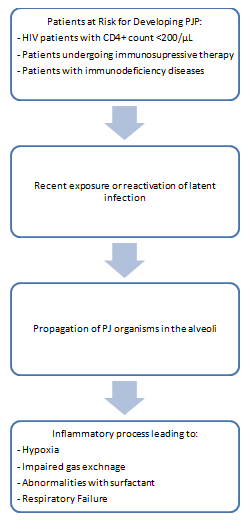Pneumocystis Jirovecii Pneumonia
Introduction[edit | edit source]
Pneumocystis Jirovecii Pneumonia (PJP) was previously called as Pneumocystis Carinii Pneumonia (PCP), it is one of the most common opportunistic fungal infection in immuno-compromised conditions such as haematological malignancy, congenital immunodeficiency, organ transplantation, immunosuppressive therapy, under medication and predominantly in HIV. [1]
Epidemiology[edit | edit source]
PJP has a high incidence before the advent of prophylaxis treatment and highly active antiretroviral therapy. A study about the epidemiology of PJP showed that the incidence has significantly decreased both for the adult and pediatric population.[2] However, the same study showed that there is difference with the prevalence of PJP in industrialized countries, such as those in Europe and North America, and in developing countries , such as in Southeast Asia and Sub-Saharan Africa, wherein the former has a continuous decline while the latter is at a greater risk of incidence.[2]
A recent nationwide study in Spain, conducted by Pereira-Diaz et al, reported that PJP is an emerging disease in patients without HIV infection of which risk factors include haematological neoplasms, chronic lung diseases and, non-hematological cancers with high mean mortality and hospitalization costs.[3]
Etiology[edit | edit source]
The pathogen responsible for PJP is Pneumocystis Jirovecii, an organism classified as a fungus.
Pathophysiology[edit | edit source]
Signs and Symptoms[edit | edit source]
- Exertional dyspnea
- Dry and non-productive cough
- Fever
- Tachypnea
- Tachycardia
- Cyanosis
Diagnostic Procedures[edit | edit source]
Differential Diagnosis[edit | edit source]
Prognosis[edit | edit source]
Pharmacological Management[edit | edit source]
Physiotherapy Intervention[edit | edit source]
Resources[edit | edit source]
References[edit | edit source]
- ↑ Ricciardi A, Gentilotti E, Coppola L, Maffongelli G, Cerva C, Malagnino V, et al. Infectious disease ward admission positively influences P. jiroveci pneumonia (PJP) outcome: A retrospective analysis of 116 HIV-positive and HIV-negative immunocompromised patients. PLoS ONE. 2017;12(5):e0176881.
- ↑ 2.0 2.1 Morris A, Lundgren JD, Masur H, et al. Current epidemiology of Pneumocystis pneumonia. Emerg Infect Dis. 2004;10(10):1713–1720. doi:10.3201/eid1010.030985
- ↑ Pereira-Díaz E, Moreno-Verdejo F, de la Horra C, Guerrero JA, Calderón EJ, Medrano FJ. Changing Trends in the Epidemiology and Risk Factors of Pneumocystis Pneumonia in Spain. Front Public Health. 2019;7:275. Published 2019 Oct 4. doi:10.3389/fpubh.2019.00275







